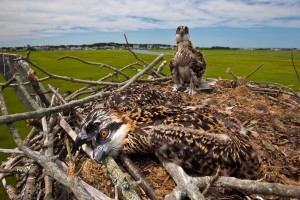A healthy population
Osprey numbers continue to rise
by Ben Wurst, Habitat Program Manager

Ospreys are currently listed as a threatened species in New Jersey. They were first listed as endangered in 1974 after the state population declined to only 50 pairs, from over 500 prior to 1950. Ospreys have made a remarkable recovery in New Jersey thanks to biologists with the Endangered and Nongame Species Program (ENSP) and many volunteers. Surveys that help monitor the population were conducted in late June and early July.
Volunteers and biologists surveyed all major nesting colonies from Sandy Hook south along the Atlantic Coast to Cape May and west to Salem County. Ospreys almost exclusively nest on man-made structures including platforms designed specifically for them, cell towers, duck blinds, channel markers, and boat lifts. Surveyors visited these nest structures to observe whether or not they were occupied. If they’re occupied, then the number of young were recorded and the young were banded for future tracking with a USGS bird band. Preliminary results show that productivity rates are up for all nesting colonies except one (Sedge Island WMA). Since ospreys are predators, they are at the top of the food chain. They are considered to be an indicator species, or a species that is sensitive to changes in environmental conditions and can serve as an indicator of an unhealthy marine ecosystem. Basically, a healthy osprey population means a healthy marine ecosystem.
The climate during this summer has been the complete opposite as last year. It was hot, dry, and calm, with only a few severe storms with high winds that caused some nests to fail. Otherwise, fish stocks are plentiful, especially menhaden. This year many out-of-state commercial fishing boats have started fishing for bunker off New Jersey waters. This is mostly due to declines in herring stocks in New England and the high demand for bait for use in lobster pots. State legislators have introduced a bill that would limit boats from catching bunker for use as bait. Read more here and this press release from the Recreational Fishing Alliance.
Full results from this years survey will be published soon in our annual newsletter. Here is last year’s newsletter.